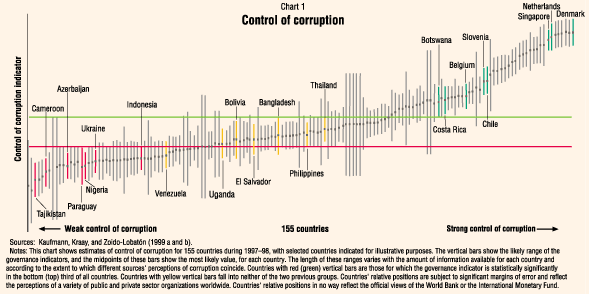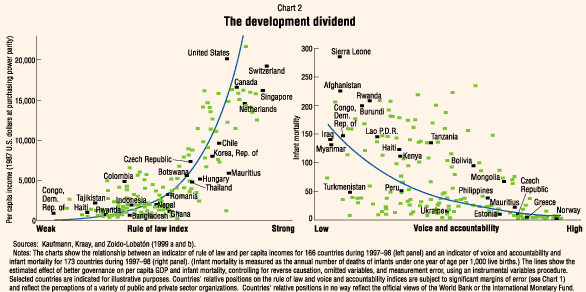 About F&D Subscribe Back Issues Write Us Copyright Information Use the free Adobe Acrobat Reader to view a pdf file of this article
|
Governance Matters: From Measurement to Action Daniel Kaufmann, Aart Kraay, and Pablo Zoido-Lobatón Policymakers generally rely on anecdotal evidence to assess the quality of governance, but this information is often misleading and incomplete. How can governments and civil society best encourage institutional change by developing and applying a systematic approach to measuring governance, its determinants, and its consequences? Ukraine's living standards steadily declined during the 1990s. Much of this decline has been ascribed to weak governance in the form of ineffective rule of law, inadequate protection of property rights, widespread corruption, and ill-advised policymaking serving special interests. Countries like Ukraine and Russia are far from unique in facing a serious governance challenge (which their newly elected governments may try to address). Practical experience in many countries suggests that weak governance and slow economic development go hand in hand, while improved governance fosters development success. The same is true at the subnational level. In Argentina, corruption in procurement and budget allocation was found to be common in the province of Corrientes. In contrast, in the city of Buenos Aires, a participatory program to enhance transparency in procurement is bringing about major improvements. And in Campo Elias, Venezuela, far-reaching municipal reforms cut corruption in half and improved efficiency . These examples suggest that while governance failures are widespread and costly, good governance provides significant benefits. They also pose two challenges:
|
|
Measuring governance We define governance as the traditions and institutions that determine how authority is exercised in a particular country. This includes (1) the process by which governments are selected, held accountable, monitored, and replaced; (2) the capacity of governments to manage resources efficiently and formulate, implement, and enforce sound policies and regulations; and (3) the respect of citizens and the state for the institutions that govern economic and social interactions among them. A wide variety of cross-country indicators shed light on the various dimensions of governance. In our work, we have identified several hundred such indicators. (See Kaufmann, Kraay, and Zoido-Lobatón, 1999 a and b for details.) Primarily measured in qualitative units, these indicators are produced by a range of organizations (commercial-risk-rating agencies, multilateral organizations, think tanks, and other nongovernmental organizations). They include the perspectives of diverse observers (experts, businesses, and private citizens) and cover a wide range of topics (political stability and the business climate, the efficacy of public service provision, experiences with corruption, and so on). These qualitative data are relevant for measuring governance. For some aspects of governance—for example, corruption—only qualitative data are generally available, although, as we will see below, new types of surveys are beginning to provide improved quantitative governance indicators. Moreover, stakeholders' perceptions of the quality of governance—as reflected in these qualitative ratings—matter at least as much as objective data (from official statistics) and often more accurately reflect actual outcomes. For instance, property rights are legally guaranteed in virtually all countries. Yet effective enforcement of those rights by the courts varies widely. When enterprises perceive that courts do not enforce these rights, the enterprises will look for other, less efficient ways of enforcing contracts. Being precise about imprecision Sifting through this wealth of qualitative data, one might have several skeptical reactions. Are these data informative—what, for example, can business analysts on Wall Street possibly know about corruption in Moldova or Niger? Are these data coherent—do data on enterprises' perceptions about political pressures on civil servants or on the time enterprises' employees spend waiting for customs clearances each tell us something about government effectiveness in general, or do they measure totally different things? Are the data comparable—can we compare a score of 3 out of 4 in a set of transition economies with a 7 out of 10 in a set of Asian countries? More broadly, are these data useful in carrying out econometric analyses and formulating policy advice? These questions motivate our empirical work. We start from the assumption that available indicators shed light on a fairly small number of broad concepts of governance, which include the following six: voice and accountability, political instability and violence, government effectiveness, regulatory burden, rule of law, and control of corruption. Based on this, we assert the following: First, within each of these six groups, the data are coherent in the sense that each individual indicator provides some useful information (that is, an imperfect signal) of the broader concept of governance to which it is assigned. Second, the data are informative. If they were not, we would not see the surprisingly strong agreement across sources about the quality of governance. Particularly striking is the broad consensus that emerges when one compares responses of risk-rating-agency analysts with those of businesses or citizens in a country. International analysts bring a global view while businesses and citizens bring local knowledge, and generally their views coincide. The statistical methodology we use shows, not surprisingly, that some individual sources provide better signals about the quality of governance than others do, but no source is entirely uninformative. Third, although different sources measure governance in very different units, statistical techniques are available that allow us to anchor each source in a common set of units, making them comparable. We use an "unobserved-components model" to extract a statistical consensus from the many available indicators corresponding to each of the six broad governance concepts mentioned previously. The resulting aggregate governance indicators efficiently summarize the data available and cover virtually all countries in the world. Because they draw on information from many different sources, the aggregate governance indicators are more precise than any individual indicator. Furthermore, we can quantify this precision. For example, Chart 1 presents data on the aggregate "control of corruption" indicator. Countries are ordered along the horizontal axis according to their rankings on this index. The vertical axis shows the range of statistically likely values of the index as a vertical line for each country, with the midpoint indicating our best estimate of control of corruption for that country. The control of corruption varies widely across countries. More important, the statistically likely range for each country's estimate is also very large, suggesting that even efficient aggregate indicators are relatively imprecise, because many countries' likely ranges of governance overlap. Needless to say, each individual indicator is even less precise!
 This imprecision indicates that running "horse races" between countries to determine their precise rankings on governance is not useful. It is more appropriate to simply group countries into three broad categories along various governance dimensions, using a "traffic light" approach. We also illustrate this approach in Chart 1, which presents selected countries in three broad categories: countries in "governance crisis" (in red), countries "at risk" (in yellow), and countries "not at risk" (in green). This broad categorical approach flags vulnerabilities and points to the need for reform without encouraging fruitless debate about the precise scores or rankings assigned to particular countries. Governance matters Does the imprecision of these aggregate indicators imply that they have limited value? Not at all. Although imprecise, they can identify the group of countries facing major governance challenges. Furthermore, they can be used to systematically assess the benefits of good governance for a large sample of countries. Not surprisingly, good governance is strongly correlated with better development. But we can go further than this obvious correlation, which might simply reflect the fact that richer countries are able to "afford the luxury of good governance"—as is argued by some of the practitioners of the worst governance in the world. In our research, we found a large causal effect running from improved governance to better development outcomes. An improvement of one standard deviation in the rule of law from the low level prevalent in Russia to the "middling" level in the Czech Republic or, alternatively, a reduction in corruption from the very high level prevalent in Indonesia to the lower level in Korea leads to between a two- and fourfold increase in per capita incomes, a decline in infant mortality of similar magnitude, and an improvement of 15-25 percentage points in literacy levels. Two examples of this "development dividend" are shown in Chart 2, which shows the beneficial impacts of improved citizen "voice" on infant mortality, for a sample of 173 countries, and of improved rule of law on per capita income, for a sample of 166 countries, using data for the late 1990s. These large causal effects suggest that good governance should be given a high priority on the development and poverty-reduction agendas.
 Developing in-depth diagnostics Aggregate indicators based on existing sources of governance data are a powerful tool for drawing attention to relevant issues. They are also indispensable for cross-country research into the causes and consequences of governance. But they are a blunt tool to use in formulating policy advice. To move forward, we need better data and better tools. There is considerable scope to improve the quality of internationally comparable governance indicators. One such effort is the World Business Environment Survey, which will cover some 10,000 firms in about 90 countries. This survey asks detailed questions about various dimensions of governance and probes quantitatively into issues typically considered as qualitative. For example, it elicits specific information about the share of bribes paid in total revenue and on the percentage bribe fee "cut" in public procurement projects, rather than vague opinions regarding countrywide corruption. With the European Bank for Reconstruction and Development's participation, this enterprise survey is virtually complete for transition economies. By investigating grand forms of corruption, such as "state capture" through the purchase of decrees and parliamentary laws and public procurement kickbacks, this survey approach provides new insights into the prevalence and implications of enterprises—including firms benefiting from foreign direct investment—engaging in grand corruption. This suggests a need to address the incentives for perverse corporate strategies and state capture when formulating anticorruption strategies. Yet better cross-country data from one survey can take us only so far. Countries embarking on governance and anticorruption programs need to analyze in depth the specific institutional challenges they face. Country diagnostic tools such as those developed at the World Bank Institute, in collaboration with others inside and outside the World Bank, can help generate new information, build local capacity, develop strategies and policies, and support coalition building to improve governance. Key ingredients of these governance diagnostics are in-depth, country-specific surveys—carried out by domestic nongovernmental organizations—of thousands of households, enterprises, and public officials that gather specific information about vulnerabilities within the country's institutions. The "self-assessment" responses of these three groups of stakeholders are compared for consistency and pooled to facilitate in-depth analysis and identification of priorities for action. (See World Bank Institute and Europe and Central Asia Public Sector Group, 1999 for details on implementation of a process also supported by bilateral donors and nongovernmental organizations such as Transparency International and the Carter Center.) For instance, diagnostics performed in Albania, Bolivia, Ecuador, Georgia, Latvia, and Paraguay have identified key areas for reform such as the legal/judiciary, customs, police, and the subnational level of government, and are also providing empirical insights into the governance-poverty nexus. Surveys of public officials are particularly relevant. Their candid responses—protected by anonymity—to very specific questions on governance in their agencies are making a difference in persuading political establishments to take difficult reform decisions. These surveys shed light on the political-economy and institutional causes of governance failures and point to specific public sector reforms. For example, recent surveys in Cambodia, Ecuador, and Paraguay have identified important variables that are inversely related to levels of corruption in public agencies, such as meritocracy in hiring, promotion, and firing; effectiveness of information flows; absence of arbitrary discretion in decision making; and transparency in budget management. The clear empirical results for these variables contrasted with the more ambiguous results for, say, salary levels or the existence of strict penalties on the books. Finally, the survey evidence vividly illustrates the social costs of corruption. For example, results from Bolivia and Ecuador show that the poor are often discriminated against in the provision of public services and that the costs of bribery fall disproportionately on poorer households and smaller enterprises. In Georgia, 77 percent of firms report they would be willing to pay an average of 11 additional percentage points of their gross revenues in taxes if corruption were eliminated. Clearly, corruption is very costly for national treasuries as well as for households and firms! The use of self-diagnostic data by a variety of stakeholders and their dissemination through participatory workshops have helped mobilize broader coalitions to support collective action and spur institutional reforms. Albania's national governance workshop took place at the same time as the 1998 World Cup soccer semifinals in France. The head of government presided over the workshop, and the cabinet and hundreds of civil society stakeholders participated. It featured a presentation of the main findings of the in-depth diagnostic results and a debate on the priorities for action, and concluded with a commitment by the leadership to an improved governance program. The next day, the front pages of all newspapers in Tirana featured charts showing the results of governance diagnostics, with detailed reporting inside. The World Cup results were relegated to the back pages! Today, with the support of a World Bank loan, Albania has embarked on an anticorruption program featuring judicial and customs reform. Countries such as Bolivia, Georgia, and Latvia have progressed from diagnostics to concrete action. In Bolivia, civil service and procurement reform are being emphasized, while in Latvia, tax and customs reform have become priority items on the national agenda. In Georgia, after abysmal results on corruption in the judiciary were obtained in diagnostic surveys, President Eduard Shevardnadze decided that all judges had to be retested. The testing took place last summer, on television! Two-thirds of the judges failed the exam and have been replaced. And in cities such as Campo Elias, Venezuela, and Ternopyl, Ukraine, the combination of the evidence from a recent governance survey and collective action by civil society is leading to improvements in local government effectiveness, a greater "voice" for citizens in government decisions, improved government accountability to citizens, and better provision of public services. Using data to encourage action A wealth of cross-country indicators of various aspects of governance now exist and strongly suggest that governance has a major impact on development. But even the best cross-country governance indicators remain imprecise and say little about the specific institutional failures that bring about weak governance in a particular setting. The real challenge lies in working with countries to empirically diagnose, identify, and address these failures at the national, subnational, and corporate levels and in understanding the key linkages between them. The enormous potential of information to identify policy priorities, empower stakeholders, and build political consensus for concerted and informed action to improve governance is only beginning to be realized as a small but growing number of courageous national, municipal, and corporate leaders muster support for these governance-enhancing innovations.
References: Joel Hellman, Geraint Jones, and Daniel Kaufmann, 2000, "Seize the State, Seize the Day: An Empirical Analysis of State Capture and Corruption in Transition," paper presented at the World Bank's Annual Bank Conference on Development Economics, April (Washington: World Bank), www.worldbank.org/wbi/governance/. Daniel Kaufmann, Aart Kraay, and Pablo Zoido-Lobatón (1999 a), "Aggregating Governance Indicators," World Bank Policy Research Working Paper No. 2195 (Washington), www.worldbank.org/wbi/governance/. —— (1999 b), "Governance Matters,"World Bank Policy Research Working Paper No. 2196 (Washington), www.worldbank.org/wbi/governance/. World Bank Institute and Europe and Central Asia Public Sector Group, 1999, "New Empirical Tools for Anti-Corruption and Institutional Reform: A Step-by-Step Guide to Their Implementation" (Washington), www.worldbank.org/wbi/governance/.
|